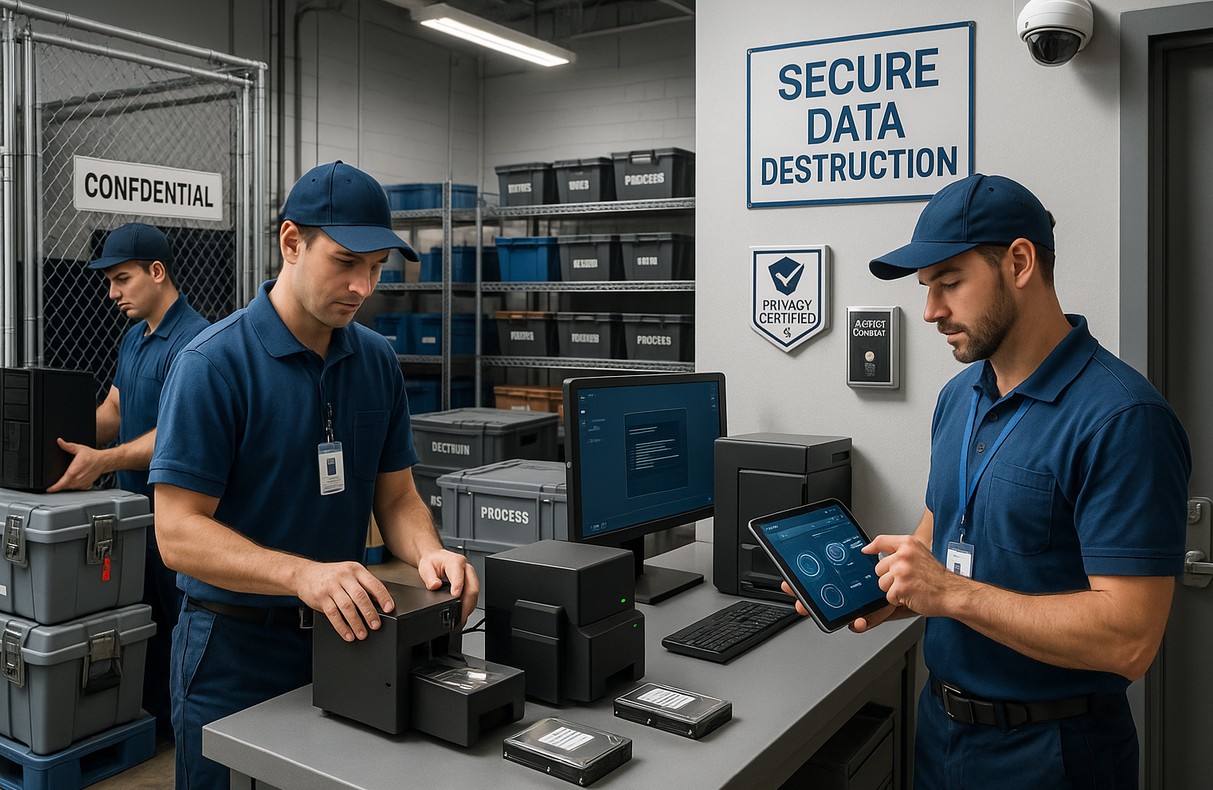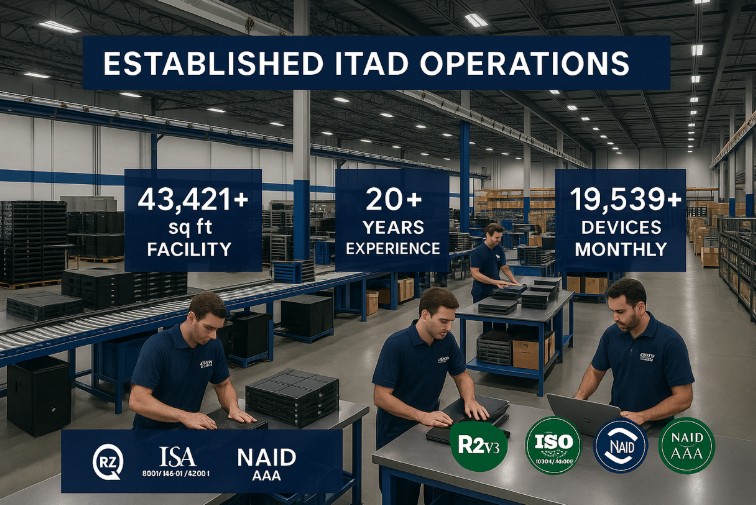In today’s digitally driven world, managing the return and disposal of IT assets isn’t just about logistics, it’s about protecting trust and sensitive data. When laptops, servers, or smartphones exit your organization, they often still hold traces of confidential information. Whether its customer records, financial documents, or proprietary code, that data must be safeguarded throughout every stage of the reverse logistics process. That’s why building airtight data privacy protocols is no longer a luxury—it’s a business necessity.
This article lays out the full landscape: from evolving data privacy regulations and automated asset management tools to sustainability goals and selecting the right IT asset disposition (ITAD) partner. You’ll learn how to turn potential risks into strategic advantages by aligning your reverse logistics strategy with modern compliance and security standards.
Overview of Reverse Logistics for IT Assets
Reverse logistics refers to the set of activities associated with the movement of products, parts, and materials from the point of consumption back to the point of origin, typically for the value recovery, refurbishment, or responsible disposal. In the context of IT assets, this includes:
- Retrieving laptops, servers, and mobile devices
- Processing returned storage devices
- Securely disposing of outdated or non-functioning hardware
This reverse journey plays a vital role in:
- Improving operational efficiency
- Supporting environmental sustainability goals
- Recovering value from unused or depreciated technology
- Minimizing electronic waste and landfill impact
Proper reverse logistics also supports complete lifecycle management, aligning with broader strategies in IT asset management (ITAM) and circular economy initiatives. Importantly, it protects sensitive data during every transition point, reducing the risk of data breaches and ensuring regulatory compliance.
The Importance of Data Privacy in Reverse Logistics
As IT assets move through the reverse logistics pipeline, ensuring data privacy becomes a core concern. Unlike traditional supply chains, reverse logistics introduces more points of vulnerability, especially when devices pass through multiple stakeholders or transit points.
Why data privacy is essential during reverse logistics:
- Preventing data breaches that could expose confidential records
- Maintaining compliance with evolving global data protection regulations
- Preserving brand reputation and customer trust, particularly in data-sensitive industries
By embedding strong privacy protocols across all stages of reverse logistics, organizations can proactively reduce security risks and ensure alignment with regulatory and corporate governance standards.
Trends and Challenges in Data Privacy Management
The reverse logistics environment is becoming increasingly complex. Companies now face evolving regulatory demands, rising volumes of data, and the growing sophistication of cyber threats. Meeting these challenges requires a combination of strategic planning, advanced tools, and industry expertise.
The Rise of Global Privacy Regulations
Modern compliance demands are intensifying. Key developments include:
- GDPR mandates the “right to be forgotten” and strict data retention limits
- CCPA requires transparency in data collection, use, and sharing
- Overlapping international regulations that vary by region and industry
For companies operating across borders, keeping pace with shifting data privacy laws is essential. Failure to comply can result in significant legal and financial repercussions.
Meeting Compliance Requirements in Reverse Logistics
To remain compliant, organizations must implement:
- Verified chain-of-custody for all IT devices
- Secure and standards-compliant data erasure
- Audit-ready reporting that documents each step of the disposition process
Without a clear compliance framework, companies risk data mishandling, which could expose them to violations and operational setbacks.
The Risks and Impact of Data Breaches
Key vulnerabilities in the reverse logistics chain include:
- Third-party mishandling of data-bearing devices
- Inadequate tracking during shipping or transfer
- Residual data left on decommissioned hardware
Even a seemingly minor data breach can cause long-term financial and legal issues. Avoiding these risks requires robust security protocols and vigilant vendor oversight.
Role of AI and Automation in Data Privacy
AI and automation are becoming indispensable tools in reverse logistics, helping businesses. streamline operations while strengthening data security. These technologies increase efficiency, reduce human error, and provide real-time visibility into IT asset movement and status.
AI-Powered Asset Tracking and Risk Management
Modern AI systems provide powerful capabilities, including:
- Real-time monitoring of asset locations
- Predictive analytics for high-risk devices
- Anomaly detection in device behavior
AI improves visibility and control across the return chain, allowing companies to manage high volumes of IT assets and mitigate risks proactively.
Automated Data Security During Asset Returns
Automation strengthens security by minimizing human error and standardizing compliance procedures. Key benefits include:
- Scheduled and automatic data erasure based on asset status or location
- Centralized tracking systems for consistent chain-of-custody documentation
- On-demand audit report generation for compliance and regulatory reviews
By automating these core processes, businesses can enforce consistent compliance, reduce costs, and accelerate returns management.
Sustainability and Data Privacy: A Unified Approach to Responsible IT Management
Combining sustainable practices with robust data protection is essential for responsible IT asset management. As more companies prioritize environmental accountability, it’s critical to ensure data security is not overlooked in pursuit of sustainability goals.
Integrating Circular Economy Principles with Data Security
To align sustainability with security, organizations should:
- Refurbish devices with certified data erasure methods
- Reuse components within the organization after secure sanitization
- Track assets throughout the return and redeployment process
Ensuring that data privacy isn’t sacrificed during reuse initiatives reinforces the value and safety of sustainable IT programs.
Environmentally Responsible Data Disposal Practices
Proper disposal of irrecoverable devices must address both environmental and compliance needs. Best practices include:
- Partnering with certified recycling facilities
- Physically destroying (shredding) or degaussing media that cannot be reused
- Maintaining Certificates of Destruction for audit trails and documentation
Organizations committed to sustainability and compliance must treat secure data disposal as a critical pillar of holistic environmental responsibility.
Implementing Secure Asset Disposition Practices
Secure IT asset disposition plays a pivotal role in modern business security strategies. From data sanitization to environmentally responsible disposal, ITAD ensures that end-of-life assets are retired without putting company data at risk.
The Importance of Certified Data Wiping
Certified data wiping:
- Fulfills legal, regulatory, and contractual obligations
- Protects against data breaches and information leaks
- Reduces liability throughout the asset retirement process
Data sanitization must be systematic, verified, and thoroughly documented to maintain both security integrity and regulatory compliance.
Techniques for Thorough and Secure Disposal
Approved IT asset disposal techniques include:
- Multi-pass overwriting to ensure data cannot be recovered
- Physical shredding of hard drives and solid-state media
- Magnetic degaussing for tapes and other magnetic storage
Employing these techniques helps close security gaps and provides audit-ready documentation for compliance and reporting.
Partnering with Certified ITAD Vendors
Choosing the right ITAD vendor is critical to maintaining control over your reverse logistics process. Certified vendors bring both peace of mind and performance assurance through proven protocols and documented practices.
Benefits of Certification: NAID AAA and R2 Standards
Certifications aren’t just badges they’re proof that a vendor consistently meets rigorous benchmarks for security and sustainability. These standards verify that your partner follows best practices at every step, from data erasure to environmental disposal.
NAID AAA and R2 certifications are widely recognized across the industry. They provide a level of credibility that gives internal teams, stakeholders, and auditors confidence in your ITAD process. These standards ensure:
- Rigorous audit trails and traceability
- Environmentally sustainable disposal practices
- Adherence to industry-leading data privacy protocols
How to Choose the Right ITAD Partner
Not all ITAD vendors offer the same level of accountability. Selecting a partner should go beyond cost—it’s about trust, documentation, and compliance. A vendor that checks the right boxes helps protect your organization from data breaches and compliance failures.
Here’s a practical checklist when evaluating providers:
- Holds up-to-date NAID AAA and/or R2 certifications
- Delivers complete chain-of-custody documentation
- Offers secure on-site and off-site destruction services
The ideal ITAD partner should align with your regulatory and sustainability goals while offering flexible, transparent support tailored to your operational needs.
Cloud-Driven Reverse Logistics and Privacy
Cloud platforms are streamlining and securing IT asset returns like never before. By providing real-time visibility and automating compliance, these tools integrate privacy protocols seamlessly into the return workflow.
Cloud Solutions for Enhancing Data Security
Advantages of cloud-based reverse logistics tools include:
- Centralized monitoring and asset tracking
- Automated alerts for compliance and privacy risks
- Customizable dashboards for real-time audit readiness
These tools not only improve efficiency but also enhance security visibility and operational control.
Collaborative Approaches to Data Privacy
Effective privacy enforcement requires:
- Cross-departmental coordination between IT, Legal, and Logistics
- Shared responsibility, standard operating procedures (SOPs), and escalation protocols
- A unified platform for managing privacy across the asset lifecycle
Cross-functional collaboration ensures consistent security enforcement throughout the organization, from device retrieval to final data destruction.
Best Practices for Data Security Protocols
Maintaining strong data security policies is essential to preventing breaches and staying compliant. It also empowers teams to confidently manage IT assets throughout all stages of return, reuse, and retirement.
Comprehensive Data Security Policies
Effective data security policies should:
- Define clear roles and responsibilities for data ownership
- Specify approved destruction methods (e.g., wiping, degaussing, shredding)
- Include oversight protocols for third-party vendors and ITAD partners
These guidelines establish a consistent framework for accountability and help enforce best practices across departments.
Monitoring and Reporting for Regulatory Compliance
Recommended tools for ongoing compliance:
- Real-time IT asset tracking systems
- Automated compliance report generators
- Cloud-based dashboards for centralized monitoring
These technologies streamline compliance, reduce manual workload, and ensure your organization remains audit-ready at all times.
Strengthening Data Privacy in IT Asset Returns
Optimizing data privacy in reverse logistics requires more than just secure disposal—it demands the alignment of security, regulatory compliance, and sustainability. Leveraging AI-powered tracking systems, certified data destruction protocols, detailed chain-of-custody documentation, and partnerships with trusted ITAD providers creates a resilient framework for protecting sensitive information and reducing risk.
When implemented strategically, these practices not only safeguard your data, they also maximize asset value, ensure audit-ready compliance, and support your organization’s long-term sustainability goals.
Ready to upgrade your reverse logistics strategy? Explore OEM Source for secure, certified solutions to power your ESG commitments forward.
Frequently Asked Questions
What are the problems with reverse logistics?
Reverse logistics can be costly, consuming 3–15% of a business’s bottom line. It also poses security risks during transport, requires precise tracking systems, and involves managing third-party logistics partners. These challenges make strategic planning and robust technology integration essential.
What are the five generic steps in the reverse logistics process?
The five common stages include:
- Receipt and inspection of assets
- Secure data erasure
- Refurbishment or repair
- Resale or recycling of usable parts
- Final disposal of non-recoverable components
Each step should include security checkpoints to ensure that data is not compromised.
What are two benefits associated with reverse logistics?
One benefit is maximizing the value of IT assets through reuse, which can achieve up to 100% value recovery. Another is reducing environmental impact by diverting electronic waste through responsible recycling or refurbishment.
How can reverse logistics create value?
Reverse logistics adds value by recovering usable assets, reducing future procurement costs, and promoting regulatory compliance. It also supports sustainability goals and helps protect brand integrity through the responsible handling of data-bearing devices.
What should I look for in a reverse logistics partner?
Choose a provider that offers NAID AAA or R2-certified ITAD services, provides full chain-of-custody documentation, includes certified data destruction, and has experience handling large-scale asset returns. A strong partner ensures security, compliance, and maximum value recovery.





